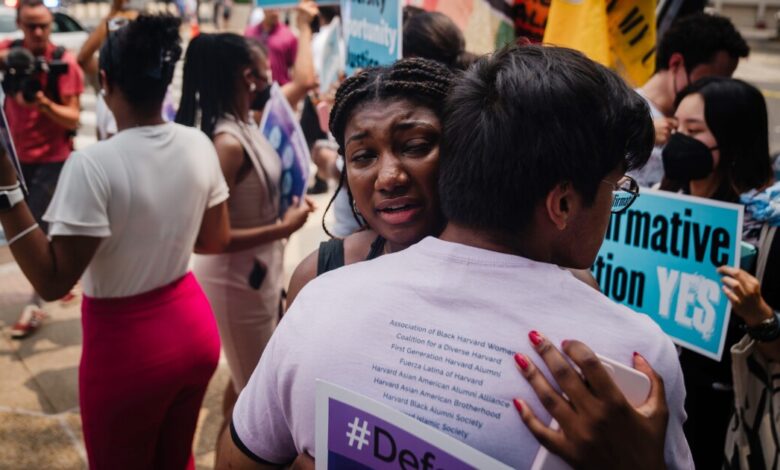College Presidents Are All Over the Map About the End of Race in Admissions

Some were aghast. Some were approving. Many used the word “disappointed.” Still others kept mum.
The Supreme Court’s long-awaited decision Thursday striking down race-conscious admissions was a Rorschach test for college leaders nationwide. Their reactions ran the gamut, creating a curtain-raiser for how the world of higher ed, which has increasingly fractured over issues of race, will start to come to grips with one of its most significant reforms in decades.
“My principal feeling is one of sadness,” Lee C. Bollinger, the outgoing president of Columbia University, told The Chronicle on Thursday.
While serving as president of the University of Michigan at Ann Arbor, Bollinger was at the center of the landmark Supreme Court decision in Grutter v. Bollinger, which two decades ago allowed colleges to consider race as a factor in the admissions process because, as the court ruled, it served a compelling interest.
Chief Justice John G. Roberts Jr., who wrote the majority opinion in Thursday’s decision, didn’t explicitly say whether that precedent had been nixed, but Justice Clarence Thomas wrote in a concurring opinion that Grutter was, “for all intents and purposes, overruled.”
Bollinger agreed.
“I think Thomas is right,” he said. “And I think that’s tragic.”
What it all means, though, seems to be up for interpretation. Arizona State University, for one, is planning “no policy changes at all,” President Michael M. Crow told The Chronicle in an interview.
Arizona State’s student body is more ethnically diverse than it’s ever been, he said. And the university will stay that way despite the decision, according to Crow, because it admits all in-state students who meet admissions requirements and doesn’t cap those enrollments.
“Race-based admissions is not necessary if there is an elimination of financial barriers, and if everyone who’s qualified is admitted,” Crow said.
The wide range of reactions from college leaders demonstrates just how much daylight there is among them as they chart a path forward, and how dependent their strategies will be on the types of institutions they lead even as some — including President Biden — call for a more-coordinated national response.
Disappointment and Deep Concern
For the presidents of Brown and Princeton Universities and Bates College — selective institutions that have used race as a factor in admissions — the mot du jour was “disappointing.”
Many leaders of similar colleges vowed to review their legal options to find new ways to preserve diversity on their campuses. Others offered more tempered responses.
Sylvia M. Burwell, the president of American University, released a statement that said the university was reviewing the decision and its implications. “We know this matter is of interest and importance to the AU community,” she wrote. In a tweet, she too said she was “disappointed but not deterred.”
“Our universities have been preparing for this ruling for some time, and are examining their admissions policies and practices to determine whether any need to be adjusted,” read a statement from Jay A. Perman, the chancellor of the University System of Maryland.
Other college presidents didn’t mince words.
“I believe that the U.S. Supreme Court’s decisions on these cases amount to government overreach into admission practices and what I view as an intrusion into how we fulfill our mission,” said Daniele C. Struppa, president of Chapman University, in California, while noting that his institution does not use race as a factor.
Darryll J. Pines, the second Black president of Maryland’s College Park flagship, said in a statement “it’s impossible to dismantle centuries of racism without acknowledging and considering race in the decisions we make today.”
Over 100 former college presidents, including a former chancellor of the University of North Carolina at Chapel Hill, signed a letter saying they were “deeply concerned” about the ruling, which they said will make colleges “significantly less diverse and higher education more segregated.”
“It is no accident that the court’s decision comes at a time when bills attacking diversity in higher education have metastasized in state legislatures across the nation, all attempting to reverse our progress toward a more inclusive democracy,” the group’s statement said.
A few college leaders, like Donald W. Sweeting, the chancellor of Colorado Christian University, praised the news. Though “racial diversity is good,” he said in a statement, “so is the affirmation of high standards and academic excellence.”
“The current practices advantage some people at the expense of others on the basis of race,” he said.
Mary J.C. Hendrix, president of West Virginia’s Shepherd University, which enrolls just over 3,000 students, said in a statement the public university prioritizes merit over race and gender, both of which it already doesn’t consider in its admissions process.
What’s next?
“It’s certainly work that has to be done as a collective,” said Kimberly Mutcherson, the co-dean of Rutgers Law School, in an interview Thursday on NBC. “A lot of us are going to be having conversations with our general counsels to figure out how we’re going to move forward here.”
If Thursday’s fallout was any indication, however, those conversations may look very different depending on the campus.
When Bollinger first became president of the University of Michigan in 1997, he was faced right away with the lawsuit challenging the university’s use of race in admissions. It was one of his first major tests as a college leader. The case ultimately preserved the practice for decades.
It was tough at first to get other colleges to line up in support of Michigan, Bollinger said — by filing amicus briefs, for example. Different college leaders face different constituencies, he said, which can make it difficult to coordinate at the national level.
Bollinger sees a through line between that experience and today. But the ultimate motivator, he said, might come down to sheer numbers. In the years since they banned race-conscious admissions, California and Michigan have seen dramatic drops in racial diversity among students on their campuses.
It’s a scenario he said will soon play out on a larger scale.
“This will become a shock to people,” he said, “when they start to look at their student bodies.”






